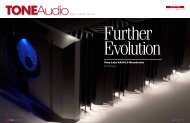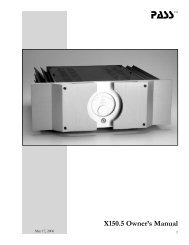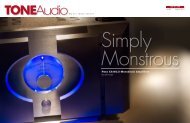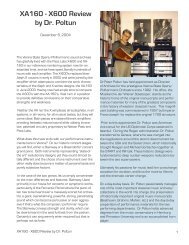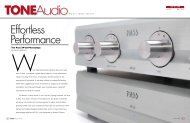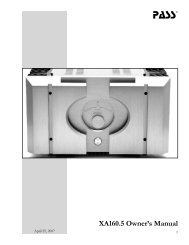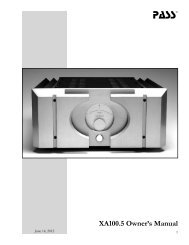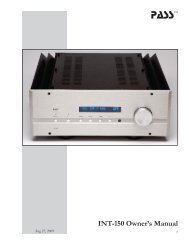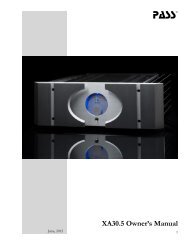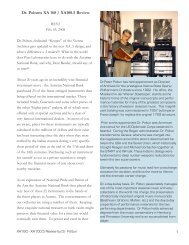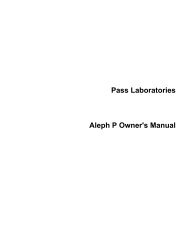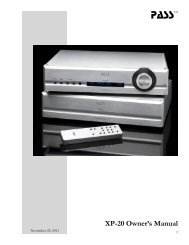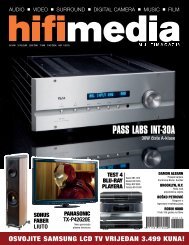XVR-1 - Pass Labs
XVR-1 - Pass Labs
XVR-1 - Pass Labs
You also want an ePaper? Increase the reach of your titles
YUMPU automatically turns print PDFs into web optimized ePapers that Google loves.
Remove the AC power cord from the <strong>XVR</strong>1 power supply before opening theenclosure of the <strong>XVR</strong>1 in order to adjust the filter settings. When the power supply isconnected to the AC wall socket there are high voltages inside.It is fairly easy to set the crossover filters with characteristics which will damageloudspeaker drivers. The <strong>XVR</strong>1 is sufficiently flexible that it can be made into anoscillator through some combinations of filter values. For this reason, set the frontpanel level controls of the <strong>XVR</strong>1 to minimum and double check the settings beforepowering up the amplifiers. After powering up both the <strong>XVR</strong>1 and the poweramplifiers, gently raise the level controls of the <strong>XVR</strong>1 while listening for any potentialnoise.Each filter of the <strong>XVR</strong>1 actually consists of two filters cascaded, each capable of 6 or 12dB/octave slopes and each capable of its own “Q” setting. For this reason, you will see thateach filter has two sets of “Q” pin settings, L, M, and H (Low, Medium, and High). Thesecan be set independently, and in this section, it is assumed that the jumpers of both are inthe M (medium) or middle position.As the two parts of each filter are cascaded, signal runs through both of them in series,however when using only one or two poles for 6 or 12 dB/octave, it is not necessary to alsorun the signal through the second part and pick up the extra noise and distortion that thesecond part contributes. To enhance performance, each filter also offers a means ofbypassing the second part when you are using 6 or 12 dB/octave slopes. In the middle atthe top of each filter you will see a 3 pin jumper switch which allows selection of either 6/12or 18/24. Selecting 6/12 bypasses the second part of the filter circuit, and selecting 18/24enables the second part also. It is not essential to bypass the second part of the filtercircuit; it will work fine on 18/24 even if you are only using a 6 dB/octave filter, but it will havea bit more noise and distortion.In the following pages we are going to show you four different setups each for high passand low pass filters, along with the resulting curves for each. Note the positions of thejumpers in each of these examples, and we hope you will gain the proper insight as to howthese jumpers work. All of the examples assume a crossover frequency of 1060 Hz, whichhas the frequency jumpers on 106 and the multipliers on X10.In each of these cases, we are going to show you a set of 4 response lines in eachfrequency response graph. These are the characteristics for the 6, 12, 18, and 24dB/octave settings. We do this so you can get a sense of the comparative response ofthese four different slopes, and we will be indicating which of the four lines matches the filtersetting shown on that page.Please note that only one channel of the crossover is shown here. You will need to set thefilters for both the LEFT and RIGHT sets of filters. The LEFT channels are in the front of the<strong>XVR</strong>1 and the RIGHT channels are in the back, and both are labeled on the left of the mainboard.By the way, we provide some extra shorting plugs packed with the <strong>XVR</strong>1 in case you lose orbreak any. If you come up short, contact <strong>Pass</strong> <strong>Labs</strong>, and we will provide you with some inexchange for a smile.7



